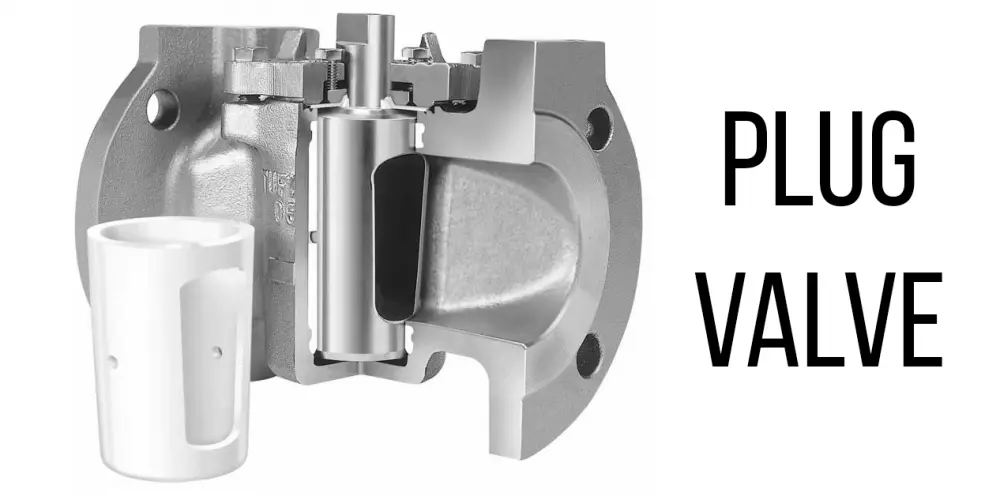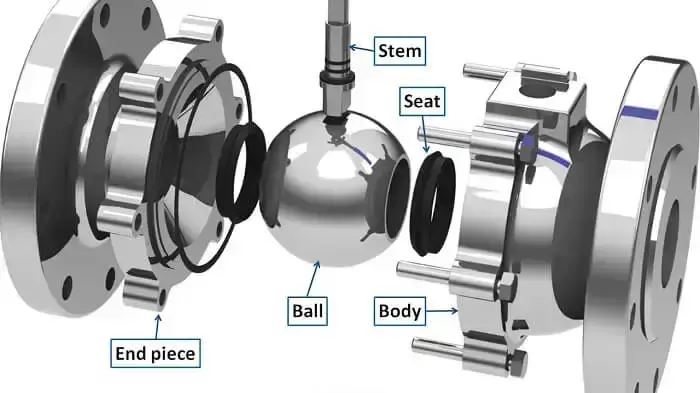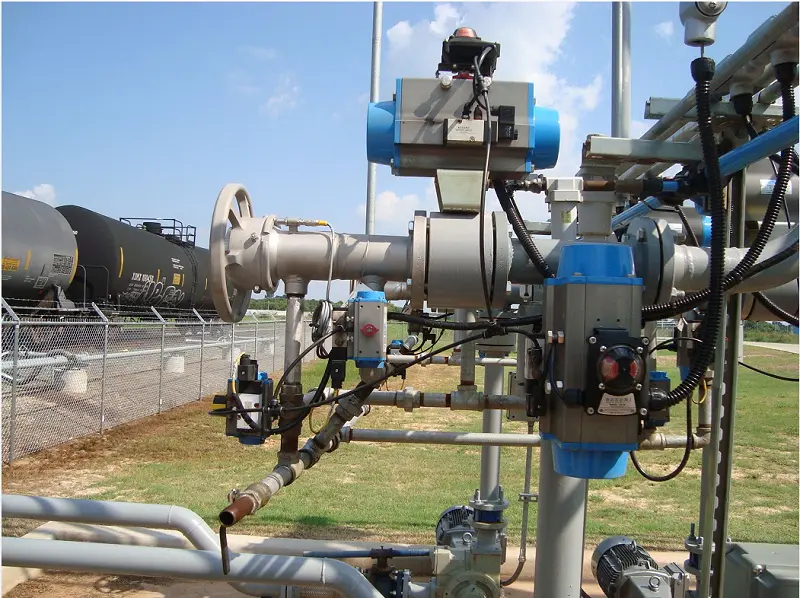What is a plug valve
A plug valve is a quarter-turn valve that regulates the flow of liquids or gases using a cylindrical or tapered plug. The flow path can be opened or closed by rotating the plug inside the valve body. Because of its straightforward construction and capacity for tight shutdown, plug valves are widely used in a variety of sectors, including chemical processing, water treatment, oil and gas extraction, and the pulp and paper industry.
What is a ball valve
A ball valve is a quarter-turn valve that regulates liquid or gas flow using a ball with a bore. To open or close the flow stream, the ball rotates on its axis. Ball valves are durable, operate quickly and effectively, and last a long time. Water distribution, industrial process cooling, and heating and cooling systems all use them.
Plug valve vs ball valve differences
Plug and ball valves differ in the following aspects:
1. Operation principle
Plug valve operation
The body of the plug valve has a parallel or tapered seat. This seat takes a plug. The plug has an aperture whose location controls how much of the valve opens. Fluid can enter or leave the valve body through these apertures, called ports. The plug fully opens or closes the fluid flow when it is twisted 90 degrees. Even still, the plug valve is not as efficient as ball valves, and it can only operate in two states: fully open or closed. It is a quarter-turn valve. Fluid flow through the valve continues when the plug's port lines up with the inlet and outlet ports. However, the smaller plug port area results in a pressure drop, which is a drawback when compared to a ball valve.Ball valve operation
A quarter-turn ball valve regulates flow by means of a hollow, perforated, and pivoting ball. The valve's basic form makes it simple to use and maintain. The ball revolves inside the valve body to regulate fluid flow. The ball is connected to a valve stem. A quarter turn of the valve stem causes the bore to become either open to the flow, allowing media to pass through, or closed, preventing media flow.2. Sealing properties
Quarter-turn valves, such as ball and plug valves, close and open in response to a 90-degree rotation of the stem. The main purpose of these valves is shut-off. There are some distinctions between them, though.Plug valve sealing
A plug valve's surface area for sealing is substantially larger than a ball valve's. Because of this, sealing capacities are enhanced, requiring more torque and operation effort.Ball valve sealing
Because they require less force to operate, ball valves are easier to use and lower in weight. These valves' smaller sealing area could result in a sealing performance that is worse than plug valves', however this problem has been successfully resolved by recent developments in chemical sealing solutions and seal injections.3. Types
Plug valve types
Plug valves are categorized according to the shape of their plugs and whether or not they are lubricated.- The purpose of lubricated plug valves is to function with a coating of lubricant between the plug and the valve body. The operational life and dependability of the valve are increased by this lubrication, which also serves to lessen friction and wear on the plug and body. In high-pressure applications, lubricated plug valves also provide better performance and a tighter seal.
Conversely, lubrication is not necessary for non-lubricated plug valves, which are usually employed in situations where the fluid under control is incompatible with the lubricant. In applications where a lubricant may provide a risk of contamination, like in the food and beverage industry, non-lubricated plug valves are also recommended.
- There are several shapes that the plug's openings might take, such as circular or rectangular.
Ball valve types
Ball valves are grouped according to a number of criteria.- Depending on the function of the circuit, 2-way, 3-way, etc.
- A bore's size and shape determine which port type it is—full port, normal port, reduced port, or v-port.
- Depending on whether the ball is supported by a pivot or floats inside the valve body, it can be either floating or trunnion.
- Ball valves with 1, 2, or 3 pieces depending on the amount of body parts.
4. Maintenance
Regular maintenance is necessary for both plug and ball valves to guarantee optimal functioning.Plug valve maintenance
Plug valves are easier to operate because of their simple construction and small number of moving parts. The rest of the valve body is simply accessible for cleaning, and it is simple to remove and clean the plug.Ball valve maintenance
The cleaning of ball valves is more difficult. It is difficult to reach the ball or disc because it is buried deep inside the valve. The ball valve's cavity may gather dirt from the medium over time, making cleaning and maintenance even more difficult.5. Cost
When it comes to operation, plug valves are more economical than ball valves. To assist keep the valve body and plug from wearing out, the plug in the plug valve fits securely under the bushing. To keep the valve operating and preserve its longevity, all that needs to be done is replace the top seal and bushing.6. Application
Plug valve application
Because of its larger surface area and unrestricted fluid flow, plug valves are appropriate for applications involving abrasive materials like sewage, muck, and slurries. They guarantee a tight seal when working with caustic materials, and their ability to resist corrosion makes them a dependable choice in difficult situations.
Ball valve application
Automation using ball valves is common, especially in fields like polymer manufacture, field gas processing, LNG facilities, and the transportation of natural gas and crude oil. Additionally, they are helpful in a variety of industrial settings, such as hydrocarbon processing, tank farms, oil refinery feedstock lines, turbine and compressor skids. For further information, see our article on ball valve applications.
7. Longevity
Plug valve longevity
Since the plug valve has a wide surface area in contact with the medium, corrosion is more likely. The plug valve is subjected to increased wear when handling greater torque.Ball valve longevity
Ball valves are designed with characteristics that keep the medium and disc from coming into contact. Long-term wear and tear is also decreased by the decreased torque. To learn more about designing a ball valve for a corrosive environment, see our article on ball valves for corrosive media.Conclusion
Plug and ball valves use a multipath functionality or a simple on/off function to control fluid flow. Consider the following factors when deciding whether to use a plug valve or a ball valve:- Because plug valves provide flawless sealing and an easy-to-understand application structure, they are the finest option for delicate applications. They are also less expensive than ball valves. They do, however, result in a pressure decrease from the intake to the outlet and are not as compact as ball valves.
- For large, high-pressure applications where simpler operation is required, go with ball valves. Compared to plug valves, they are more convenient to use and small, but their sealing power is somewhat diminished.
Table 1: Plug valve vs ball valve
| Feature | Plug valve | Ball valve |
| Operation principle | The position of the plug, which is intended to have an opening, controls how much of the valve opens. Fluid can enter or exit the valve body through these apertures, called ports. | A hollow, perforated ball that pivots is used in a ball valve to regulate flow. To regulate the flow of fluid, the ball revolves inside the valve body. |
| Sealing properties | Increased sealing surface area results in improved sealing properties, but it also demands more torque and effort to operate. | Their low torque requirements result in a smaller weight and a more controllable operation. These valves may function less well in terms of sealing than plug valves because of their smaller sealing surface. |
| Types | Plug valves are classified based on their shape (rounded, rectangular, etc.) and whether or not they are lubricated. | The size, form, and whether the ball floats inside the valve body or is supported on a pivot are the factors that categorize ball valves into distinct classes. |
| Maintenance | Easy to clean | Difficult to clean as the ball and other parts are situated deep inside the valve. |
| Cost | Less costly | More costly |
| Application | Applications involving abrasive materials, such as sewage, mud, and slurries, | Automation using ball valves is common, especially in fields like field gas processing, LNG facilities, polymer synthesis, natural gas and crude oil transmission, and home plumbing. |
| Longevity | Less durable | More durable |
FAQs
Why choose plug valves over ball valves?
Because plug valves have a larger sealing surface than ball valves, they seal better.
Are plug valves better than ball valves?
Generally speaking, plug valves are not as long-lasting as ball valves. This is due to the fact that when more fluids come into contact with the cylinder, plug valves are more likely to experience erosion. Ball valves, on the other hand, have more moving parts, less torque requirements, and less fluid interaction.
What is the difference between an eccentric plug valve vs a ball valve?
A ball valve uses a ball with a bore to control the flow of liquids or gases, whereas an eccentric plug valve features a plug-shaped, eccentrically rotating flow-restricting component.
